Art Amid The Flames Of War
By Zanyar Omrani
11 April, 2015
Countercurrents.org
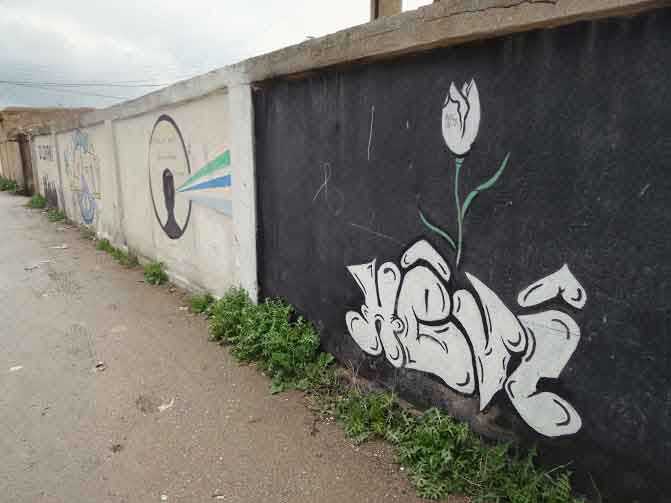
I saw their works around the city and I got curious. It wasn’t difficult to find the creators in a small town. A few simple questions from the locals were enough to find their hangout, and it took only half an hour.
The street is where graffiti art present itself, and this kind of art is a means of expression of social and political protest.
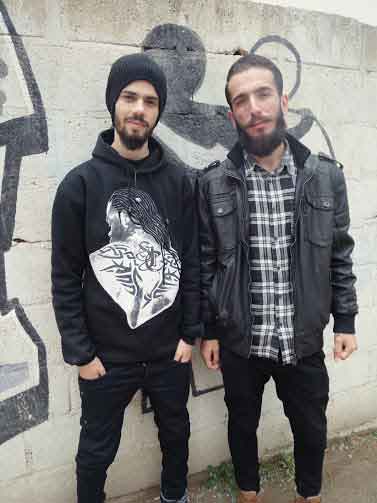
Syria has gained the capacity to tolerate ‘sin’. Omar Shiyukh and Ram Aslan, two ‘sinful’ young men, appreciate the streets, where there is no need for majestic galleries, well-equipped amphitheater, and useless attached pieces of paper. They have occupied Amuda, a small Kurdish town in northern Syria.
Graffiti, a popular art now, only needs a wall and some color-and-brush equipment. No art connections needed also. They say that their works are immediately available for the people in public places and help them get rid of their monotonous environment for some moments.
As to the Syrian civil war, the story of a group activity called "The Nation Wants the Endof the Regime" by some students, which played a role in igniting the war, has been often neglected. This activity led to the arrest and torture of some students in Dar’aa, resulting in subsequent protests. Then, Mohammad Khonji, a graffiti artist from Damascus, was arrested, and the murder of Mohammad Ratib was the ultimate evidence for Assad regime’s obstinate determination to oppress the graffiti artists. (1)
It is some days after the Newroz explosions in Hasakah and I’m in Jazira canton now. The town is still quiet, but the small friendly gatherings in the teahouses linger on. Some people are still busy analyzing the elections before Newroz, and some talk about the Newroz explosions.
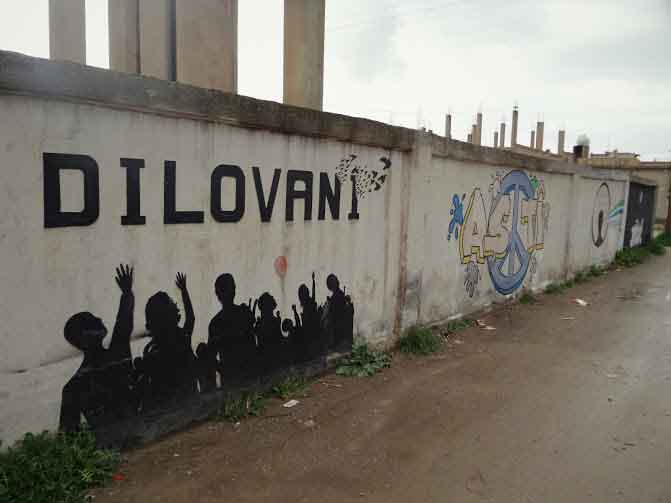
I was walking around the streets and viewing the environment when I noticed the three-dimensional patterns on the walls. It is amazing to see such modern patterns in a place like Rojava (Syrian Kurdistan) which has been under attack by different Islamic fundamentalists, and while there are still ongoing clashes in some fronts like Sarikani and Hasakah.
A few questions helped to find the graffiti artists’ address. Two young men, aged 22, with the unusual appearance common among such artists with bizarre caps and black clothes. At first glance, Ram looked very placid. He lit his Kent cigarette. Having noticed his bizarre tattoos, I asked what they meant, and the answer was, “Forget about them. I dunno.” I wanted to joke with Omar and asked him if he was a relative of Omar the Rashudin Caliph. The answer was strong, “No, I’m an atheist!” And he immediately asked where I was from, and realizing I was from Iran, he spoke his mind, “Why don’t you stop supporting Assad?” With the same radical temperament peculiar to their age, they talked about God’s nonexistence. They said they were anarchists, and both believed ISIS to be “the real manifestation of true Islam.”
Graffiti groups in Syria are not few, but it’s only Ram and Omar in Kurdish populated areas. I asked Omar about extending their work to other Kurdish towns, and he replied, “Actually, we were going to extend our work to other Kurdish and Syrian cities, but since military service is obligatory under Assad’s regime and we haven’t done that, it’s impossible for us to travel to other cities. Ram believed that the lack of any relations among the graffiti artists in Syria and in the Middle East was a big weak point. He said, “Art has been reduced to singing in Syria. Art has to be with the people and the warriors, and this is our duty to realize this.”
Streets are not the only place where Ram and Omar’s works are displayed; they have a page on Facebook with 2000 likes where they show the pictures of their works.
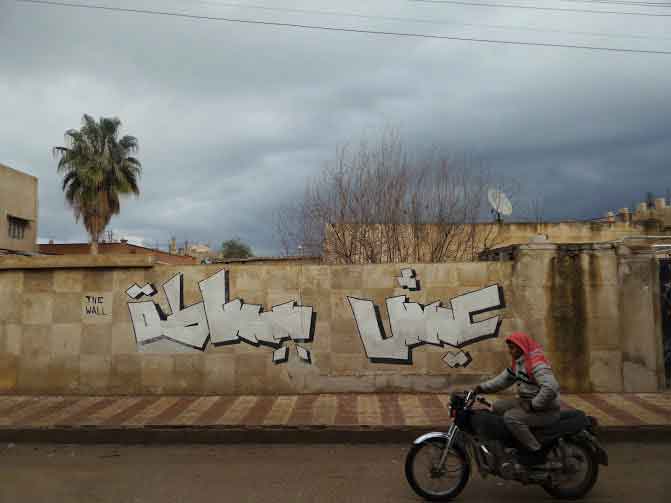
Omar and Ram are both students of agricultural engineering. They said they had learned graffiti art experimentally and with the help of the Internet and graffiti books. Banksy is their favorite graffiti art group. They listen to metal and rock music and their favorite bands are Metallica, Draconian, Pink Floyd, Evanescence, and Linkin Park; Ram doesn’t like the last one though.
They are not happy with the conditions, but they seem to be hopeful. They do photography to make a living, but they pursue graffiti art more than anything else. Ram said, “This is our main job, and we aren’t giving it up. We would like to establish a union for the graffiti artists in Rojava (Syrian Kurdistan). We should spread it.”
Ram recommended walking around the town so they can show me their works. The older works had gone pale.” Omar said, “The material is of poor quality, and they go pale after some time and a little rain.”
We kept silent for a short time while walking, and then I broke the silence by asking Omar if he is into reading books. The answer was positive, “I love Noam Chomsky’s books.” Ram added, “All books are worth reading at least once except holy books. Our dire fragile situation in Rojava is because of these books.”
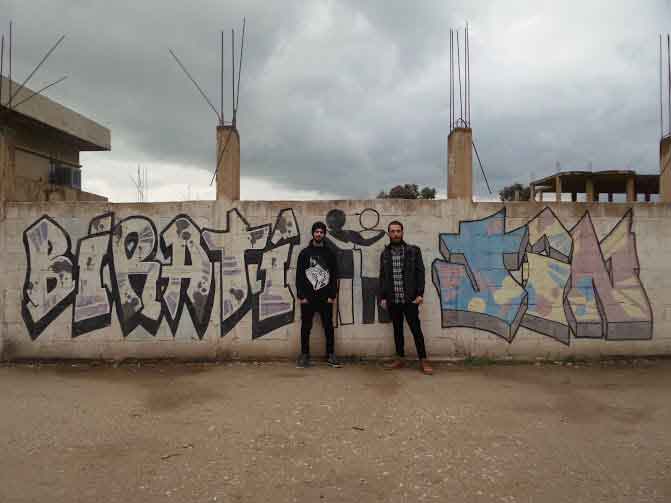
We were going down a street when suddenly Omar sighed, pointing to some walls, saying “Do you see those walls? They are perfect for graffiti work, but the owners don’t let us work on them because they’re afraid they may get into trouble.”
There was a picture of a political leader on the wall. Ram immediately clarified that, “This is not our work; we’re against making anyone holy.” Omar and Ram are really motivated and they have lots of plans. They are going to teach some people who show interest as soon as the raining period is over. However, this is not their first experience, as they had previously taught some people in Darbesi, but this was abandoned because of the war.”
Their first work was called Hope, which was done in the main square of the town. Ram believed that their first works met different reactions from people. “Some were against us, and some were for us, but what particularly interested us was their amazement while looking at the works,” he said.
We talked about Iran again, and I told them there is a lot of graffiti in Iran, too. Omar said, “There must be. Wherever there is oppression, graffiti mushrooms.”
Omar and Ram try to be independent and do their best not to get any help from anyone, but graffiti material is expensive. Jazira Canton Self-Rule has helped them in some cases to acquire suitable color and brushes, but Ram said, “We don’t expect much from them, since the canton is at a fierce exhausting war.”
Ram believed that the very essence of graffiti art is incompatible with asking for permissions, but due to the special conditions in Rojava and the fact that their works had not been completely accepted by the people, they asked for permissions for their works from the self-rule of the canton.”
They are both worried about their town. Omar said, “The war and widespread unemployment have caused many young people to run away and the town is rather empty.” I asked why they had not left, and Omar replied, “We intend to stay whatever the conditions are.” They hope, “The young people who have fled will come back soon and take part in rebuilding Amuda and Rojava, because running away doesn’t help.”
I asked them if they had ever been toying with the idea of going to the fronts. The answer was, “The girls are stronger than us. We are not like them.”
Zanyar Omrani is a filmmaker and Kurdish human rights activist.
Translated by: Farhad Khoshyar
.
Comments are moderated

